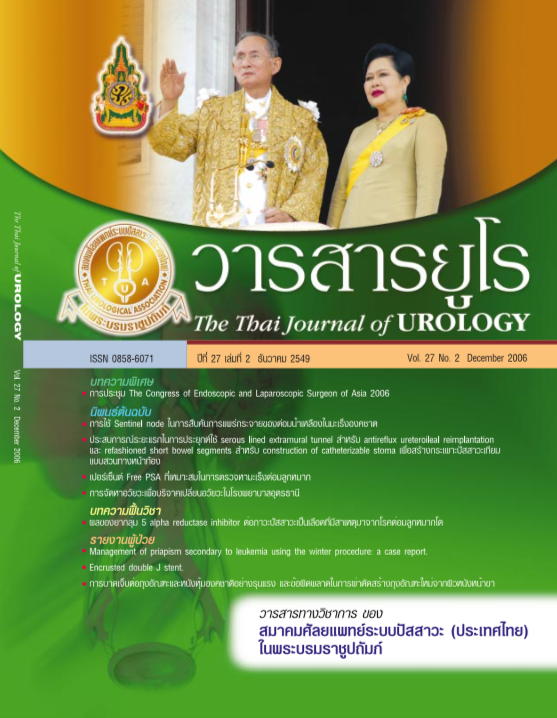Applications of the Serous Lined Extramural Tunnel for Antireflux Ureteroileal Reimplan- tation and Refashioned Short Bowel Seg- ments for the Construction of Catheterizable Stoma in Cutaneous Continent Urinary Diver- sion: Early Clinical Experience
Keywords:
Serous Lined Extramural Tunnel, Antireflux Ureteroileal Reimplan- tation, Short Bowel Segments, Catheterizable Stoma, Cutaneous Continent Urinary DiversionAbstract
Purpose: To report the early results of a new surgical procedure for cutaneous continent urinary diversion by using serous lined extramural tunnel for antireflux ureteroileal reimplantation and double Monti ileal tube with flap valve mechanism to construct a continent catheterizable stoma.
Materials and Methods: Three female patients with a mean age of 44 years have undergone cutaneous continent urinary diversion by using serous lined extramural tunnel for antireflux ureteroileal reimplantation and double Monti ileal tube with flap valve metchanism to construct a continent catheterizable stoma. Anterior pelvic exenteration was done in 1 patient with urethral carcinoma, 2 patients from bladder carcinoma. This report described surgical procedure and followed the result by observe and questionnaire about the problems with self clean intermittent catheterize stoma or any leakage of urine from stoma. Ultrasound and cystogram was done 3 months postoperatively and every 6 months thereafter to evaluate the configuration of the upper tract and to assess the reflux.
Results: All three patients had no problem with self clean intermittent catheterization nor leakage of urine from stoma. Ultrasound evaluated upper tract showed no hydronephrosis and no reflux to upper urinary tract by cystography, after follow up from 8 to 21 months with a mean follow up of 10 months.
Conclusions: After anterior pelvic exenteration and bladder was removed, the patient must be undergone urinary diversion with ileal or colonic conduit which need urostomy bag. Some patients un- dergo orthotopic neobladder if healthy urethral was available, but for the patients who had no healthy urethral and did not want urostomy bag, so another choice of operation was cutaneous continent urinary diversion which needed for self clean intermittent catheterization. This report presented the good result of surgical techniques for antireflux ureteroileal reimplantation and continent catheterizable stoma with pa- tients satisfaction after operations.
References
Grossfeld GD, Stein JP, Bennett CJ, et al. Lower urinary tract reconstruction in the female using the Kock ileal reservoir with bilateral ureteroileal urethrostomy: update of continence results and fluorourodynamic findings. Urology 1996; 48: 383-8.
Abol-Enein H, Ghoneim MA. A novel uretero-ileal reimplantation technique: the serous lined extramural tunnel. A preliminary report. J Urol 1994; 151: 1193-7.
Monti PR, Lara RC, Dutra MA, de Carvalho JR. New techniques for construction of efferent conduits based on the Mitrofanoff principle. Urology 1997; 49: 112-5.
Shaaban AA, Gaballah MA, el-Diasty TA, Ghoneim MA. Urethral controlled bladder substitution: a comparison between the intussuscepted nipple valve and the technique of Le Duc as antireflux procedures. J Urol 1992; 148: 1156-61.
Skinner DG, Lieskovsky G, Boyd S. Continent urinary diversion. J Urol 1989; 141: 1323-7.
Stein JP, Freeman JA, Esrig D, et al. Complications of the afferent antireflux valve mechanism in the Kock ileal reservoir. J Urol 1996; 155: 1579-84.
Studer UE, Gerber E, Springer J, Zingg EJ. Bladder reconstruction with bowel after radical cystectomy. World J Urol 1992; 10: 11-9.
Le Duc A, Camey M, Teillac P. An original antireflux ureteroileal implantation technique: long-term followup. J Urol 1987; 137: 1156-8.
Abol-Enein H, el-Baz M, Ghoneim MA. Optimization of uretero-intestinal anastomosis in urinary diversion: an experimental study in dogs. I. Evaluation of the Le Duc technique. Urol Res 1993; 21: 125-9.
Abol-Enein H, el-Baz M, Ghoneim MA. Optimization of uretero-intestinal anastomosis in urinary diversion: an experimental study in dogs. II. Influence of exposure to urine on the healing of the ureter and ileum. Urol Res 1993; 21: 131-4.
Stein JP, Lieskovsky G, Skinner DG. The double -T- pouch : A novel continent cutaneous ileal reservoir. J Urol 1999; 161: 67.
Gosalbez R, Wei D, Gousse A, Castellan M, Labbie A. Refashioned short bowel segments for the construction of catheterizable channels (the Monti procedure): early clinical experience. J Urol 1998; 160: 1099-102.
Hautmann RE, Egghart G, Frohneberg D, Miller K. The ileal neobladder. J Urol 1988; 139: 39-42.
Narayanaswamy B, Wilcox DT, Cuckow PM, Duffy PG, Ransley PG. The Yang-Monti ileovesicostomy: a problematic channel? BJU Int 2001; 87: 861-5



